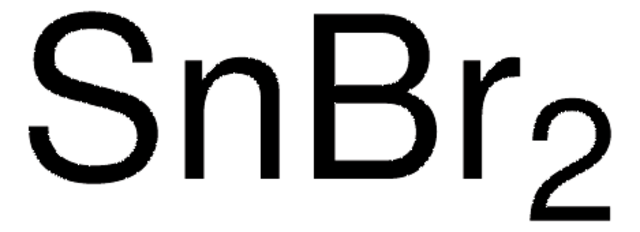409294
Tin(IV) iodide
anhydrous, powder, 99.999% trace metals basis
Sinonimo/i:
Stannic iodide
About This Item
Prodotti consigliati
Grado
anhydrous
Saggio
99.999% trace metals basis
Forma fisica
powder
Impurezze
≤15.0 ppm Trace Metal Analysis
Densità
4.47 g/mL at 25 °C (lit.)
Stringa SMILE
I[Sn](I)(I)I
InChI
1S/4HI.Sn/h4*1H;/q;;;;+4/p-4
QPBYLOWPSRZOFX-UHFFFAOYSA-J
Cerchi prodotti simili? Visita Guida al confronto tra prodotti
Categorie correlate
Applicazioni
- Influence of pi-Iodide intermolecular interactions on electronic properties of Tin (IV) iodide semiconducting complexes: This study explores the crystal structure and electronic properties of tin(IV) iodide complexed with organic ligands (E Wlazlak et al., 2016).
- Origin of Sn (II) oxidation in tin halide perovskites: This research investigates the oxidation mechanisms of Sn(II) to Sn(IV) in tin halide perovskites and its implications on material stability (J Pascual et al., 2020).
- Fluoride chemistry in tin halide perovskites: The paper discusses the impact of fluoride addition on the coordination and oxidation states of tin centers in iodide perovskites (J Pascual et al., 2021).
- Mechanochemical synthesis of Sn (II) and Sn (IV) iodide perovskites and study of their structural, chemical, thermal, optical, and electrical properties: This work details the synthesis and characterization of pure-tin and mixed tin-lead iodide perovskites (Y El Ajjouri et al., 2020).
- Degradation mechanism of hybrid tin-based perovskite solar cells and the critical role of tin (IV) iodide: This study elucidates the degradation mechanisms of tin perovskite solar cells, highlighting the role of tin(IV) iodide in this process (L Lanzetta et al., 2021).
Accessorio
Avvertenze
Danger
Indicazioni di pericolo
Classi di pericolo
Acute Tox. 4 Dermal - Acute Tox. 4 Inhalation - Acute Tox. 4 Oral - Eye Dam. 1 - Resp. Sens. 1 - Skin Corr. 1B - Skin Sens. 1
Codice della classe di stoccaggio
8A - Combustible corrosive hazardous materials
Classe di pericolosità dell'acqua (WGK)
WGK 3
Punto d’infiammabilità (°F)
Not applicable
Punto d’infiammabilità (°C)
Not applicable
Dispositivi di protezione individuale
Eyeshields, Faceshields, Gloves, type P3 (EN 143) respirator cartridges
Certificati d'analisi (COA)
Cerca il Certificati d'analisi (COA) digitando il numero di lotto/batch corrispondente. I numeri di lotto o di batch sono stampati sull'etichetta dei prodotti dopo la parola ‘Lotto’ o ‘Batch’.
Possiedi già questo prodotto?
I documenti relativi ai prodotti acquistati recentemente sono disponibili nell’Archivio dei documenti.
I clienti hanno visto anche
Il team dei nostri ricercatori vanta grande esperienza in tutte le aree della ricerca quali Life Science, scienza dei materiali, sintesi chimica, cromatografia, discipline analitiche, ecc..
Contatta l'Assistenza Tecnica.













